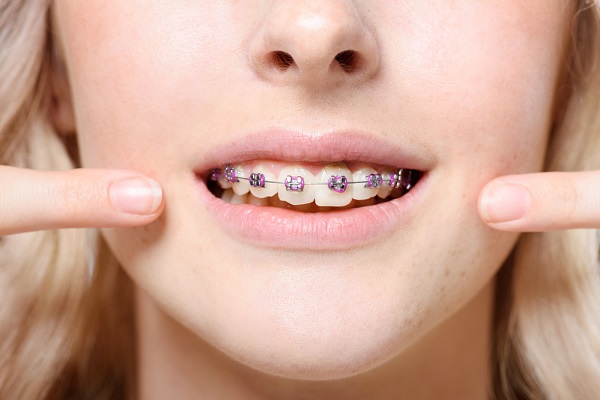Orthodontic patients get braces to correct overbites, underbites, and other misalignments of teeth. With braces come a period of adjustment for your mouth, some at least initial difficulty in eating or talking, and restrictions on certain foods. You also get discomfort that is caused in part by the contact of the braces’ parts with your mouth. The answer is found in wax designed for those with braces. Below, we explain what does wax do for braces, how to apply braces wax, when to wear it, and teeth care when you use it.
What Is Wax Used for Braces?
The ingredients that make up wax for braces come in both man-made and natural form. In the natural form, caranuba wax, the beeswax from insects, and minerals found with microcrystalline and paraffin are ingredients for orthodontic wax.
Whether synthetic or natural, contact of the wax with your mouth or even throat is not harmful. The wax used for braces contains no toxic material. In rare cases, the beeswax in some wax for braces mixtures might trigger chronic inflammations or infections, and could stunt bone development.

What Does Wax Do for Braces?
A set of metal braces results in your mouth housing a considerable amount of hardware. You are dealing with brackets, archwire, and perhaps ligature wires. Because it protrudes, archwires are particular culprits of the nuisance pain in your mouth. Some patients wear appliances such as the Herbst appliance in their mouths.
Friction and irritation occur as these components rub against teeth, gums, and lips. Wax for braces exists to remove the discomfort by creating a barrier or block between the brackets, archwires, or other parts of the braces and the surfaces in your mouth.
What to Know Before You Apply Braces Wax
Knowing how to use wax for braces involves preparation. As you’ll read below, you mainly use your fingers to apply it. As a result, you must thoroughly wash your hands before touching the wax. Use hot water and soap and thoroughly rinse. This is especially important if you have handled raw meat, poultry, or seafood. Wash off peppers, spices, salt, sugar, and other ingredients. Otherwise, you risk introducing dirt, grease, germs, and other unsanitary materials to the mouth.
Also, use care if your fingers (or you) have cuts, scrapes, or sores. The fingers may also deliver bacteria or infections into your mouth.
Brush your teeth before applying the wax, so that you have clean teeth and surfaces when you employ the wax. If the wax has not succumbed to wear, don’t rush for the wax or the toothbrush immediately after eating. If you wear braces, you’ll generally need an hour between the last bite and brushing. This means that you normally should wait at least an hour after a meal or snack before you go to the wax. Ibuprofen or acetaminophen can afford some temporary relief from any interim pain or discomfort.
How to Apply Braces Wax: Method and Frequency
- With clean hands and a clean mouth, take a piece of the wax from its holder.
- Form a small ball or pellet.
- Press the resulting mold, making it flat, upon the area of pain or discomfort on the teeth.
- Use the index finger and thumb for best results.
Replace your wax at least twice a day and don’t allow it to stay in your mouth for more than two days at a time. Keeping wax on for a considerable amount could invite the accumulation of bacteria. At some point, the wax will harden to a point that it starts to break. Reapply it when this happens.
When to Take Off the Wax
- Before Brushing: Take off the wax before brushing so it does not leave clumps on the toothbrush.
- Eating and Drinking: Wax likely will fall off when you eat or drink. If you’re having only water, you can likely use the same wax you were using because you don’t need to brush. Use a fresh piece after eating or drinking sugary beverages since you will need to brush to have a clean area to apply the wax.

- Sleeping: Since it is not toxic, sleeping with orthodontic wax does not pose a contamination risk. Keeping it in at night may counteract pain that could worsen because your jaw muscles are not working against the pain. However, the wax might become a choking hazard. Using a pain reliever such as acetaminophen or ibuprofen might offer some relief if you are awakened by pain.
How to Remove Braces Wax
Now that you know how to apply braces wax, it is time to also learn how to remove it. If you leave it on long enough, the wax will fall on its own as flakes.
To remove wax for other reasons, including to eat or drink, you have at your disposal toothpicks, toothbrushes, floss, and your hands. In hard to reach places, try a toothbrush because of its length and ability to navigate those areas. Wet the bristles first so that the wax will not become attached to them. If you use your fingers and hands, wash up first so that you don’t introduce germs and bacteria into your mouth.
Should You Reuse Braces Wax?
The question may be better asked, “Why would you want or need to reuse wax?” Packets of wax for braces do not cost much. Some orthodontists may offer complimentary wax after the braces first go on, or during checkups and adjustments of the hardware.
Over time, the wax will become harder or will otherwise lose its effectiveness as a buffer between the braces components and your mouth. If you have just put it on, but need to remove it to drink or eat, then it may be wise to replace it.
Conclusion
Learning how to apply braces wax effectively means more than placing it on the achy or irritated teeth or gums. It includes consistent brushing and flossing so that the wax doesn’t contribute to teeth infections. You also need to know when to use and replace the wax, which is what we explored in this article. Please share your experience with how to apply braces wax, or tell us if you have other alternatives for handling the friction of braces.

Leave a Comment